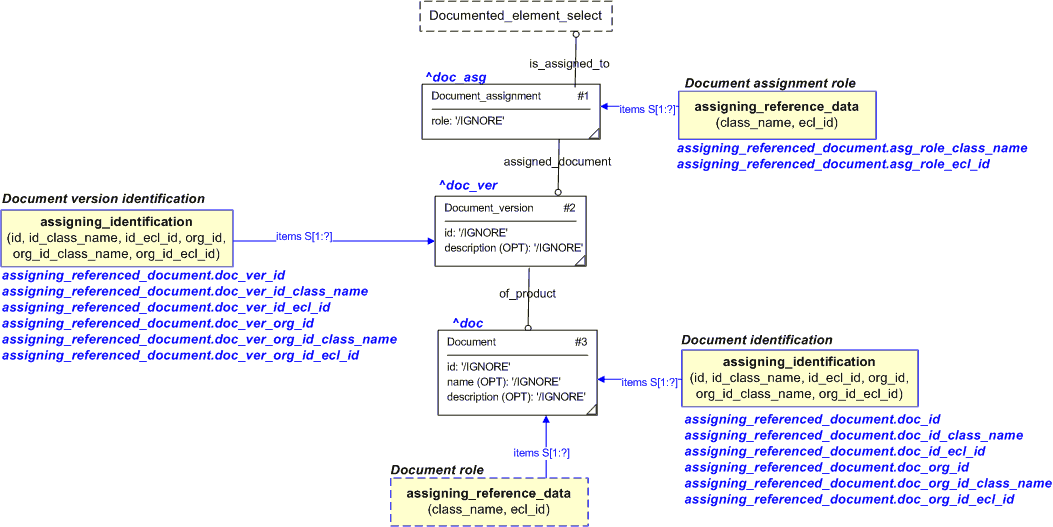Template:— assigning_referenced_document (asg_ref_doc)
Context:— NDLO |
Date: 2008/02/21 16:26:54
Revision: 1.3
|
This section specifies the template assigning_referenced_document.
NOTE
The template has been defined in the context of
NDLO.
Refer to the business context for details of related templates.
NOTE
An explanation of a template and the associated instantiation path is
provided in the
Template overview
section.
This template describes how to assign a complete document to product and support data without its views.
The EXPRESS-G diagram in
Figure
1
shows the templates and EXPRESS entities that are required
to represent the template
"assigning_referenced_document".
The text highlighted in blue shows the template parameters.
...
Figure 1 — An EXPRESS-G representation of the Information model for assigning_referenced_document
The graphic for the template to be used in other EXPRESS-G diagrams
is shown in Figure
2
below.
...
Figure 2 — The graphical representation of the assigning_referenced_document template
The following input parameters are defined for this template:
The name of the class in the reference data library
(
External_class)
being used to determine the role of the assignment.
The following classes and their sub-classes can be used:
The identifier of the document
The following classes and their sub-classes can be used:
The location of the
External_class_library
that stores the classifications used to classify the document, document_version and document_definition.
The name or identifier of the organization responsible for the document representation
The name of the class being used to classify the identification (
Identification_assignment)
of the organization responsible for creating the document representation
The following classes and their sub-classes can be used:
The identifier of the
External_class_library storing the
definition of the class used to classify the organization identifier.
The version identifier of the document version
The following classes and their sub-classes can be used:
The location of the
External_class_library
that stores the classifications used to classify the document, document_version and document_definition.
The name or identifier of the organization responsible for the document representation
The name of the class being used to classify the identification (
Identification_assignment)
of the organization responsible for the document representation
The following classes and their sub-classes can be used:
The identifier of the
External_class_library storing the
definition of the class used to classify the organization identifier.
The following reference parameters are defined for this template:
Allow the
Document_assignment
entity instantiated in this path to be referenced when this template is used.
%^target = $assigning_referenced_document.doc_asg%
Allow the
Document
entity instantiated in this path to be referenced when this template is used.
Note: The
Document
entity can be referenced in a template path by:
%^target = $assigning_referenced_document.doc%
where
target
is the parameter to which the
Document
is bound.
Allow the
Document_version
entity instantiated in this path to be referenced when this template is used.
%^target = $assigning_referenced_document.doc_ver%
The instantiation path shown below specifies the entities that are to be
instantiated by the template.
A description of templates and the syntax for the instantiation path is
provided in the
Templates Help/Information section.
Document-- Mark the Document entity as -- referable when this template is used by binding it to the reference -- parameter id_assgn %^doc =
Document%
^doc.id = '/IGNORE'
^doc.name = '/IGNORE'
^doc.description = '/IGNORE'
-- Identify the Document /
assigning_identification(
items=^doc,
id=@doc_id,
id_class_name=@doc_id_class_name,
id_ecl_id=@doc_id_ecl_id,
org_id=@doc_org_id,
org_id_class_name=@doc_org_id_class_name,
org_id_ecl_id=@doc_org_id_ecl_id )/
Document_version-- Mark the Document_version entity as -- referable when this template is used by binding it to the reference -- parameter ^doc_ver %^doc_ver =
Document_version%
^doc_ver.id = '/IGNORE'
^doc_ver.description = '/IGNORE'
-- Identify the Document_version /
assigning_identification(
items=^doc_ver,
id=@doc_ver_id,
id_class_name=@doc_ver_id_class_name,
id_ecl_id=@doc_ver_id_ecl_id,
org_id=@doc_ver_org_id,
org_id_class_name=@doc_ver_org_id_class_name,
org_id_ecl_id=@doc_ver_org_id_ecl_id )/
-- Relate the document_version to the document
^doc_ver.of_product ->
^doc
Document_assignment-- Mark the Document_assignment entity as referable when this template is used. -- In other words, bind the Document_assignment instance to the reference -- parameter doc_asg %^doc_asg =
Document_assignment%
^doc_asg.role = '/IGNORE'
-- Assign the role through ref data /
assigning_reference_data(
items=^doc_asg,
class_name=@asg_role_class_name,
ecl_id=@asg_role_ecl_id)/
-- Assign the document to entity it is used for
^doc_asg.assigned_document ->
^doc_ver
-- Assign to document version
^doc_asg.is_assigned_to ->
@is_assigned_to
The following entities are instantiated with attributes as specified:
The instance diagram in Figure
3
shows an example of the EXPRESS entities and templates that are instantiated by the template:
/assigning_referenced_document(is_assigned_to='#1', asg_role_class_name='Support_document', asg_role_ecl_id='urn:plcs:rdl:std', doc_id='....', doc_id_class_name='Document_identification_code', doc_id_ecl_id='urn:plcs:rdl:std', doc_org_id='...', doc_org_id_class_name='Organization_name', doc_org_id_ecl_id='urn:plcs:rdl:std', doc_ver_id='...', doc_ver_id_class_name='Version_identification_code', doc_ver_id_ecl_id='urn:plcs:rdl:std', doc_ver_org_id='... ', doc_ver_org_id_class_name='Organization_name', doc_ver_org_id_ecl_id='urn:plcs:rdl:std')/
(an illustration of the consolidated assigning_referenced_document template is shown in
Figure
4 below.)
Figure 3 — Entities instantiated by assigning_referenced_document template
The instance diagram in
Figure
4
shows the graphic symbol for the template that is to be
used in other instance diagrams. The example template is:
/assigning_referenced_document(is_assigned_to='#1', asg_role_class_name='Support_document', asg_role_ecl_id='urn:plcs:rdl:std', doc_id='....', doc_id_class_name='Document_identification_code', doc_id_ecl_id='urn:plcs:rdl:std', doc_org_id='...', doc_org_id_class_name='Organization_name', doc_org_id_ecl_id='urn:plcs:rdl:std', doc_ver_id='...', doc_ver_id_class_name='Version_identification_code', doc_ver_id_ecl_id='urn:plcs:rdl:std', doc_ver_org_id='... ', doc_ver_org_id_class_name='Organization_name', doc_ver_org_id_ecl_id='urn:plcs:rdl:std')/
Figure 4 — Instantiation of assigning_referenced_document template
The following section details how the
assigning_referenced_document
template can be optionally characterized by assigning
other constructs to it. These are characterizations commonly
applied to the template. The ISO 10303-239 EXPRESS model may enable
other assignments to the entities instantiated by the template.
The following characterizations may apply:
Characterization Assigning classifications
NOTE this characterization is optional.
Document may be classified to provide further semantics to the data.
The classification of a document is represented using the template
assigning_reference_data
to assign a class to a
Document.




